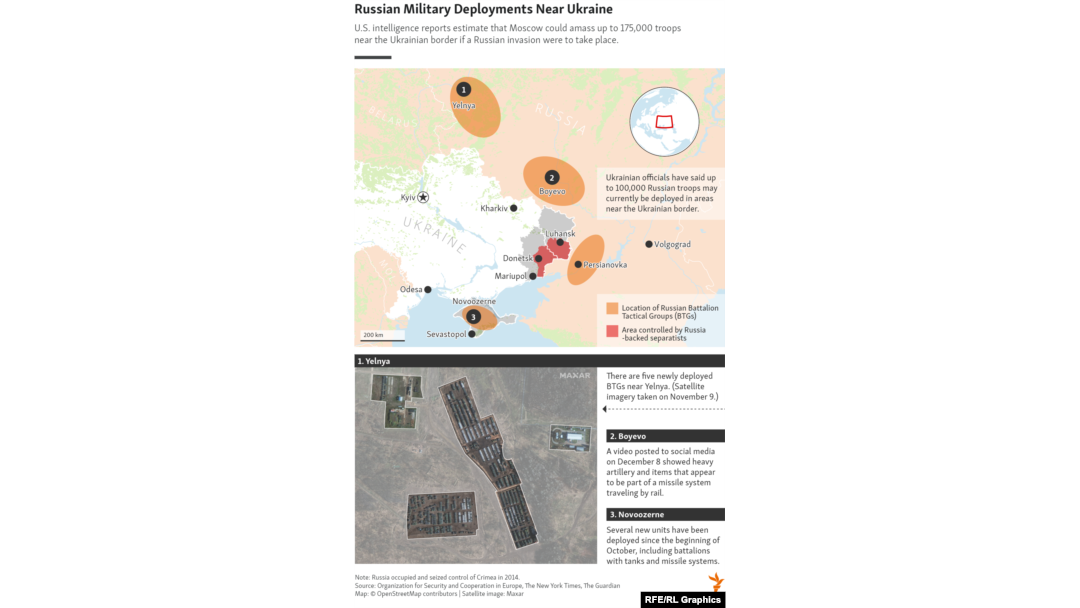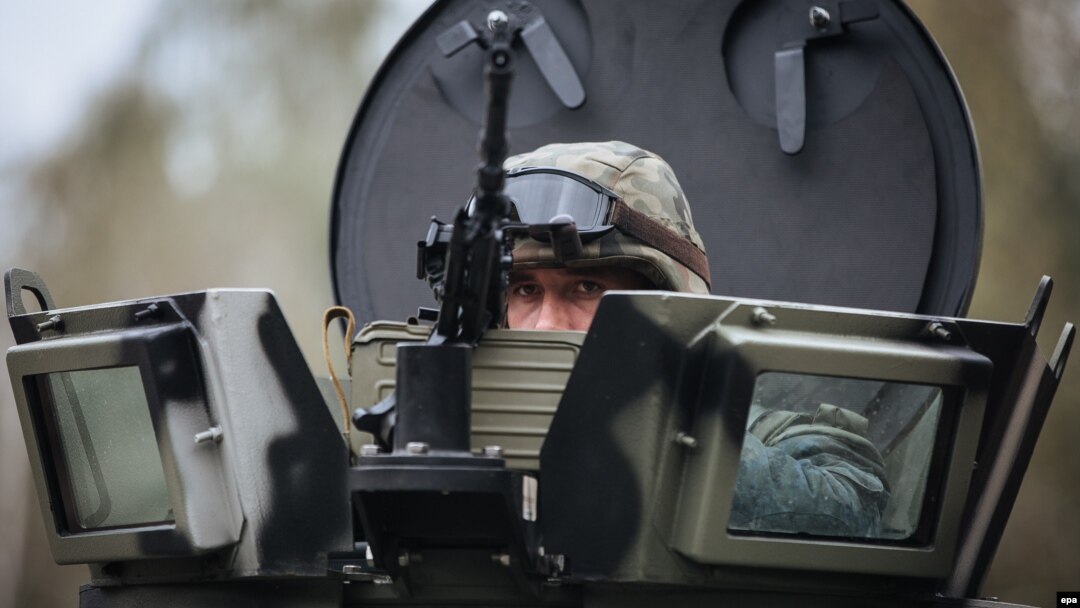It was a large-scale Russian military invasion of Ukraine involving around 130,000 military personnel, mainly from the 20th and 8th Combined Arms Armies.
Paratroopers from the 76th and 98th Air Assault Divisions crossed the Ukrainian border from the north, headed toward Kharkiv. From the southeast, units including the 7th and 106th Air Assault Divisions moved to seize the entirety of the already partly occupied Donetsk and Luhansk regions, and then move as far west as the outskirts of Dnipro, another major city. Smaller special operations units -- spetsnaz -- were also deployed.
Railway choke points leading to the Ukrainian borders hampered full deployment, but still, the advance units were followed in rolling waves by multiple regiments with thousands of troops over the next 10 days.
The goal? "Seizure of parts of Ukraine for incorporation into the Russian state."
The scenario, published more than 18 months ago, was part of a war-game exercise conducted by the Rand Corporation, a U.S. think tank. Though not a comprehensive analysis, it's a snapshot of Russia's military capabilities in eastern Ukraine, where in reality, just across the border, as many as 175,000 Russian troops may be gathered in the coming weeks.
And while the Rand report and more recent military analyses have examined Russian operational tactics, far fewer have looked at the other side of the coin: How long could Ukraine's armed forces hold out against a bigger, more powerful military force like Russia's?

"Russia will find them a determined, robust, and enduring army, whatever Putin chooses to do," said Glen Grant, a retired British Army artillery officer who served as an adviser to the Ukrainian military.
"The threat has been going on for eight years. We have not ruled this out since 2014. This is war, this is Russia. Russia should be expected to exploit any situation at any moment," General Oleksandr Pavlyuk, commander of the Joint Operation Forces fighting the separatists, said in an interview with the Donbas.Realities desk of RFE/RL's Ukrainian Service.
War broke out in Ukraine's eastern Donbas region in April 2014, just a couple of months after months of street protests in Kyiv exploded in violent police clashes. That led to the ouster of the country's Moscow-friendly president, who fled to Russia.
In the months that followed, Kyiv"s "Anti-Terrorism Operation" -- a mixture of government troops and volunteer militias, often privately funded -- had initial successes against Kremlin-backed separatist forces.
By late summer, however, Russia had increased its deployment of unmarked military intelligence and even regular troops, resulting in several major defeats for Ukrainian forces, including one in the city of Ilovaysk that August.
Relatives hold portraits of a Ukrainian serviceman who was killed in the conflict in eastern Ukraine during a rally in August 2020 to commemorate the sixth anniversary of the Battle of Ilovaysk.
Those losses highlighted the weak state of Ukraine's military, which had been hollowed out by years of underfunding and corruption.
Problems included outdated equipment, new equipment sold off for kickbacks, officers forced to cover their meager salaries with outside business deals, and vehicles and helicopters lacking fuel or spare parts. Ukrainian children held bake sales to raise money for troops.
"Our army has been systematically destroyed and disarmed, and its best personnel dismissed," Deputy Defense Minister Petro Mehed told reporters in April 2014.
Since that time, the Ukrainian military has improved, though experts disagree how broad and deep the improvements are, and how much is possible when a country is still technically at war.
Aging Weaponry, Outdated Equipment
Saddled with aging Soviet weaponry and outdated equipment, Ukraine has sought to upgrade its armaments, and the United States has become the largest single supplier of lethal and nonlethal weaponry over the past seven years.
The aid, totaling more than $2.5 billion, includes things like counterartillery radars, drones, flak jackets, night-vision goggles, and armed patrol boats. It has also included sophisticated Javelin anti-tank missiles, which would potentially give Ukrainian troops a small battlefield advantage against Russian tanks.
In November, the United States delivered about 88 tons of ammunition, including nearly three dozen Javelin launchers, and 180 missiles. The new defense budget that Congress passed this week includes $300 million for the Ukraine Security Assistance Initiative.
Along with other NATO officers, the United States has also tried to improve training for Ukrainian forces; more than 150 troops from the Florida National Guard's 53rd Infantry Brigade Combat Team are currently in the country.
"The big challenge as I see it is not the military but the political," Grant told RFE/RL in an e-mail. "There is little faith in the country that the president, as commander-in-chief of the armed forces and his administration, are as prepared, thoughtful, and robust as the army and population at large. Much will depend upon what sort of attack [Russian President Vladimir] Putin decides to follow. There is no appetite in the country for political surrender."
Ukraine's military is now estimated to have a total of around 145,000-150,000 troops, with the army comprising the bulk of that. The Joint Forces Operation, which runs operations along a 400-kilometer "line of control" in the eastern Donetsk and Luhansk regions, is estimated have between 30,000 and 35,000 troops.
Your browser doesn’t support HTML5
Vox Pop: What People In Western Ukraine Think About A Possible Russian Invasion
Much weaponry and equipment remains outdated, however, with large numbers of old vehicles or old technology. The air force is a small fleet of Soviet helicopters and aging fighter jets whose effectiveness is questionable -- and would likely be wiped out quickly in the event of a major new Russian incursion, experts say.
"The Russians have learned a lot. The Russians have learned a lot from their operations in Syria, they've continued to reform their military," said Alexander Vindman, a former U.S. Army officer who served as European and Russian affairs director on the White House National Security Council.
"The Ukrainians have learned an enormous amount, but the advantage is still heavily in Russia's favor," he told RFE/RL. "So you're talking about a scenario where there could be heavier casualties, but the outcome doesn't really change."
Ukraine's purchase of Turkish-made Bayraktar TB2 drones, which played a decisive role in last year's Nagorno-Karabakh conflict between Azerbaijan and Armenia, has caught the attention of Russian forces, though it's unlikely they would play a decisive role. Kyiv has acquired 12 so far, and dozens more are reportedly on order.
"It depends on what you mean by 'withstand,'" said Tor Bukkvoll, a senior researcher at the Norwegian Defense Research Establishment, a government-funded think tank, when asked how long Ukrainian forces could hold out against a Russian invasion. "If you mean repel, then probably very little or not at all. If you mean continue to fight as an organized force, then probably days or weeks (I am guessing here)."
'Overwhelming And Crushing' Force
Ukrainian forces "are substantially improved, not least because their state in 2014 was so horrible that it does not take too much to improve quite a bit," Bukkvoll said. "I think their strong sides are combat experience, morale, and some modernization of weaponry, including from abroad.
"Their weak sides seem to be organization, loss of key personnel, and significant weaknesses in certain kinds of weaponry such as for example air defense, electronic warfare, and fighter aircraft," he said.
Open-source reporting, including satellite imagery, shows that Russia is deploying equipment and weaponry that would allow for an overwhelming onslaught if the order were given. For example, unconfirmed reports have documented trench-digging trucks seen on rail cars heading in the direction of the Ukrainian border, and Buk M-1 antiaircraft missile systems have also been spotted.
While the Rand report hypothesized a theoretical Russian advance to the east bank of the Dnieper River near Dnipro in a matter of days, other reports have suggested a Russian invasion would be so overwhelming that the capital, Kyiv, would be overrun in a matter of hours if Russia set that as an objective.
"If you look at it from a Ukrainian point of view, it depends on how many troops Russia accumulates and which areas become the goal of its operations," Konrad Muzyka, a Polish defense analyst, told RFE/RL's Russian Service. "Short-range air-defense systems, anti-tank guided missiles, everything that can slow down the speed of the Russian offensive; such weapons will be especially useful.
"Does Ukraine have military capabilities to stop a full invasion? I don't think so," Muzyka said. "There are only a few countries in the world that could stop the onslaught of the Russian Army. In case of invasion, Ukraine will need to mobilize as many reservists as possible so that it does not become an easy walk for Russia. In that case, it will be a long and bloody conflict.
"The overwhelming forces assembled [by Russia], it's designed to suppress casualties. It's designed to be so overwhelming that it crushes the Ukrainian military," Vindman said. "It's not like there will be anything left to chance, so the Ukrainians could amass anything later. It's supposed to be overwhelming and crushing."
Ukrainian soldiers walk along the line of separation from the separatists in the Donetsk region.
Russia might also stop short of a full-scale invasion and aim for limited gains, experts say: for example, to seek a solution to the water problem in Crimea, whose freshwater supply was cut off by Ukraine in the months after it was seized by Russia in March 2014. Though Russia has built a $3.7 billion bridge that links the peninsula to the Russian mainland, water supplies are a major problem.
A smaller force of Russian troops could seize the swath of Ukrainian territory along the Sea of Azov, including the major port city of Mariupol, creating a "land bridge" to Crimea, and allowing for water to be piped into the peninsula.
A more limited offensive might also be aimed at forcing Kyiv to implement a 2015 peace plan for the Donbas on Russia's terms.
And while virtually no one expects Ukraine's military to withstand a full Russian onslaught, Ukrainian officials have suggested that a determined partisan resistance might take shape depending on where and how the attack occurs.
"Then the whole thing would probably evolve into a drawn-out guerrilla war that would be very painful for both sides," Bukkvoll said in an e-mail.


